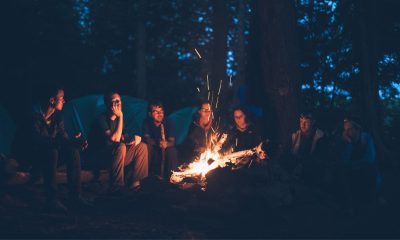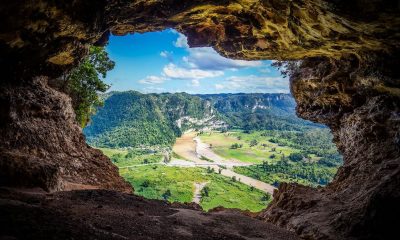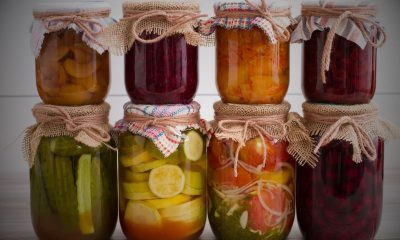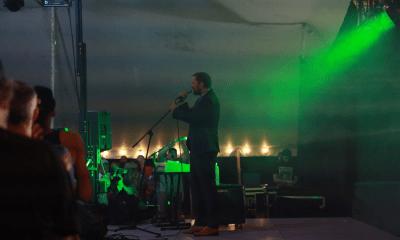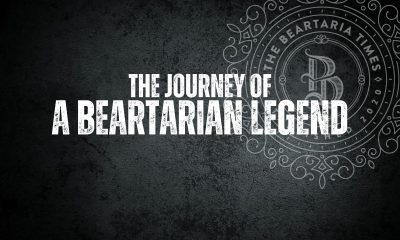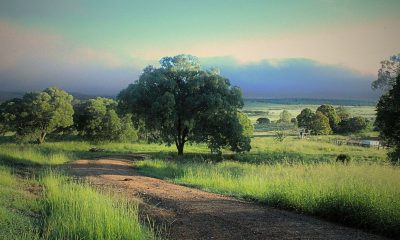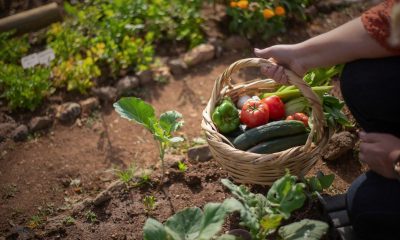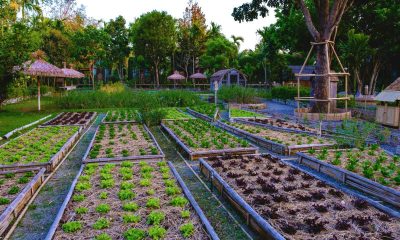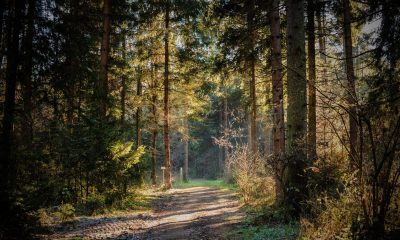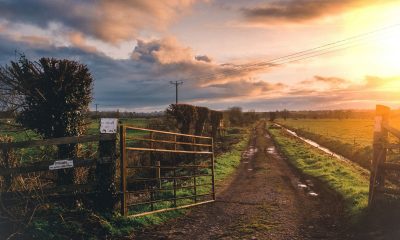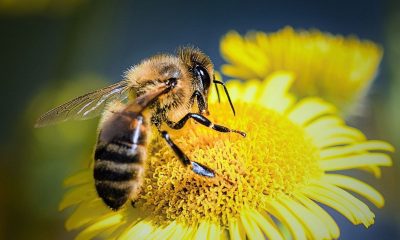Just Crushing
There is a First Time for Everything: A Lesson from a True Hunter
That evening as I sat down for supper, I watched as the snow began to fall, and after heartfelt prayer of thanksgiving, pork and sauerkraut never tasted so good.
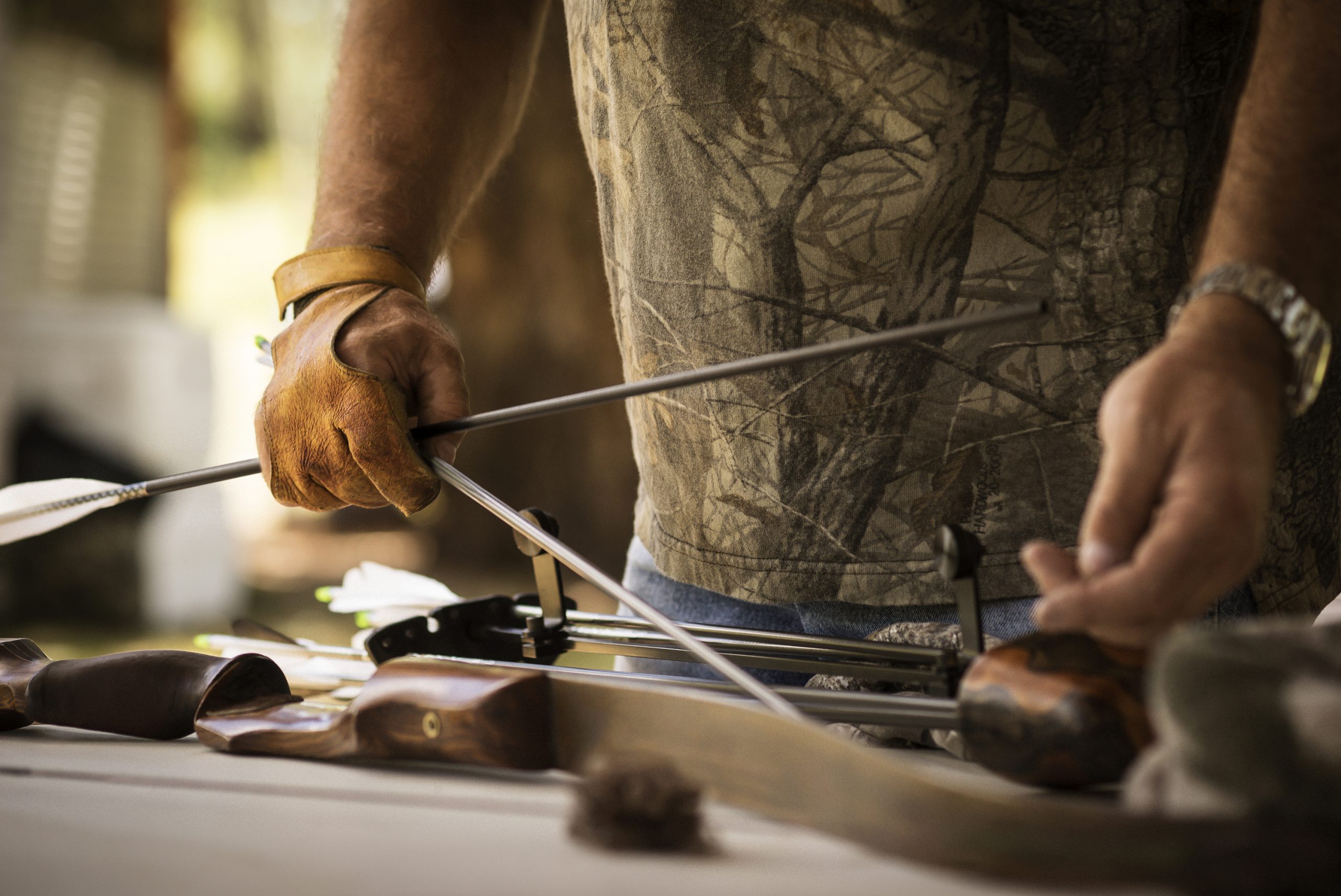
By: Longbow Bear
Every archery season is a new learning experience. Whether it’s learning how the deer move through at a new stand location, how the cuts and draws in a mountain can manipulate the wind direction, or calling to a big buck that is outside of bow range. This year was no different. My week-long “rutcation” started with two warm days, but as Monday rolled around, the temperatures plummeted, putting bucks on the move searching for does that have come into heat. Monday was a blast, having two encounters with big 8 points, one in the morning and one in the afternoon. I found the short end of the stick with both bucks as the wind swirled, and eventually, both of them nosed me before giving me a clean shot. Tuesday morning picked up right where it had left off the day before. It was cold and crisp, 25 degrees, frosty, and very little wind. Perfect. It didn’t take long for things to get busy in the woods. A little after daylight, I let a series of doe bleeds mixed with a buck-tending grunt echo down the mountain. It’s one of my favorite blind calls to make. It gives an illusion that a buck has found a hot doe and is tending her.
I’ve had good luck in seasons past at piquing the interest of a buck I couldn’t see to come to take a look. This was the case; minutes after making the call, I heard the crunching of leaves and a twig crack behind me. I arose from my seat, pulled my bow from the hook, and anxiously waited to lay eyes on what was coming through the thick. He cautiously made his way, zig-zagging through thick laurel and downed pine trees, finally showing himself and coming to a stop at 23 yards.
Getting dangerously close to directly downwind, I took a shot through a small window. My aim was true, but the location of the deer was less than desirable.
I put my pin a little too far front and caught some shoulder blade. As my arrow struck the deer, it gave a loud crack with what looked like little penetration. As I watched him run off with my arrow sticking in him, I felt sick to my stomach. What did I just do? Did I just wound a buck without making a fatal blow?
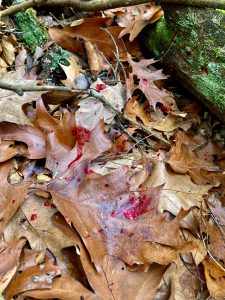
I gathered myself and got down from my tree to look and assess the damage. I found decent blood where I had hit him, my arrow was lying 10 yards from first contact, and if the blood on the arrow accurately showed penetration, I had about 8”, which was plenty to reach the vitals, but I couldn’t be sure, in my mind replaying the shot it didn’t look like that had been the case. I began to track, finding little spots of blood and upturned leaves as he was on the run. After tracking him for the first 100 yards, I saw no sign of him stopping. It was time to back out and regroup. I walked the ridge back to my stand location. I felt terrible, gathered up all my gear, and hiked back down to my truck. After a two-hour coffee break with a lot of nervousness and second-guessing, I geared up and went back in to track him.
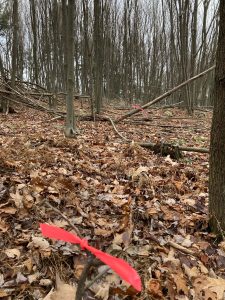
This is something I have not had to do up until this point in my hunting career. I’ve been fortunate enough to either have clean misses or deadly hits. I returned to where I had stopped, marked with my arrow stuck in the ground. Using pink ribbon, I slowly marked his travel, every spot of blood got a stick and some ribbon.
As I scoured the forest floor for drops of blood, a motivation kicked in, and the sickening feeling that I currently had started to fade with every drop that I found. Stick ribbon, stick ribbon, it was starting to be fun. Every now and again, stopping to take a break and look back at how he was weaving his way through the woods. He went about 400 yards across the ridge before hooking down into the thick laurel, where he eventually came to rest. I felt a lot of relief and gratitude when I finally saw him lying there. A hunter cannot have a worse feeling than to mortally wound an animal and never recover it. I’ve yet to experience it, and I hope I never do, but that risk comes with hunting, especially with a bow. Happy to get him back to camp, skinned out, and hanging ready for processing tomorrow. That evening as I sat down for supper, I watched as the snow began to fall, and after heartfelt prayer of thanksgiving, pork and sauerkraut never tasted so good.
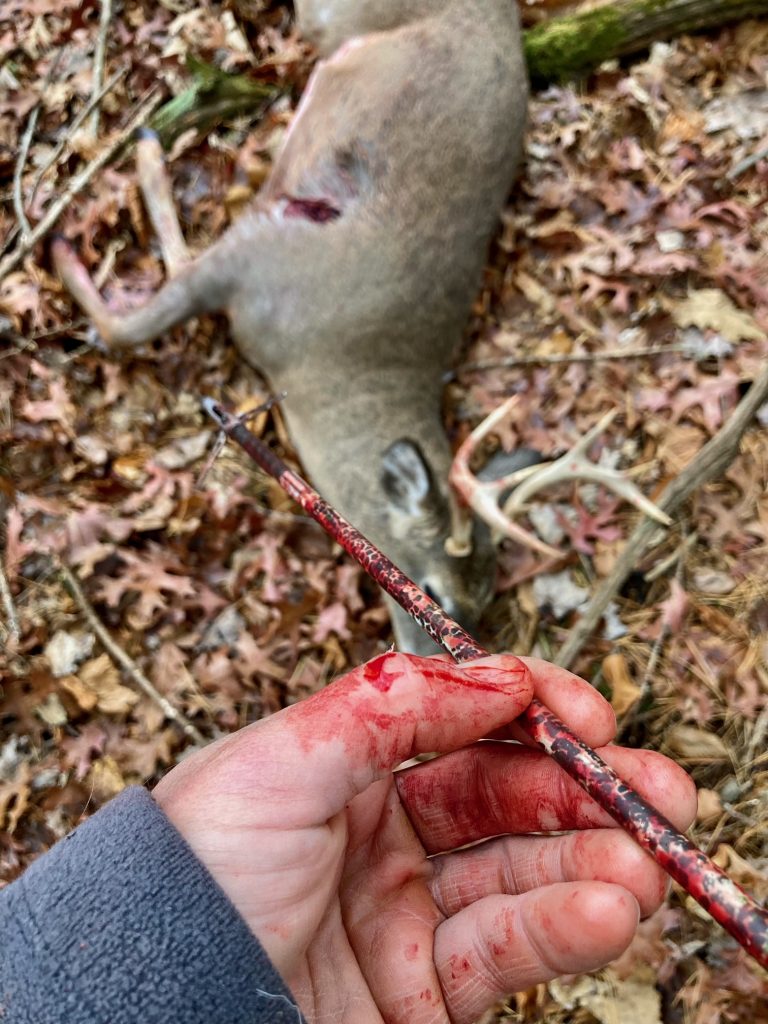
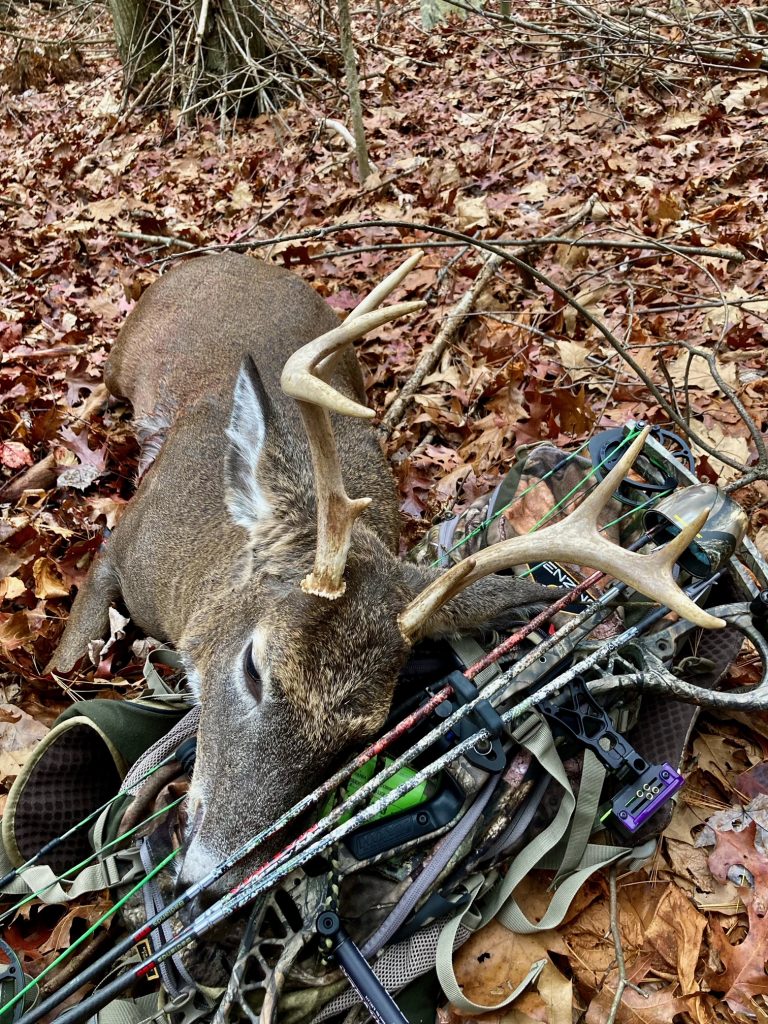
To any new hunters that find yourselves in that scenario, go look for blood and assess the damage at the place where the animal was when it was first hit. Find a trail and mark it. If there is any question on your shot placement or you didn’t see or hear the animal crash. Pack out and give it 2 hrs before further tracking. The last thing you want to do is to keep pushing a hurt animal. A mortally wounded animal will usually head toward water or a thick area to find a spot to lie down. By not pressuring the animal, he will inevitably lie down and die as peacefully as possible. This is the best-case scenario now that you have made a less-than-perfect shot. I hit one lung, and this buck still managed to go 400+ yards from where I hit him.
Just Crushing
Comedian Owen Benjamin Disrupts The Comedy Scene
Congratulations to Owen Benjamin and the Unbearables Media Team for the Launch of “Must Be Nice”!
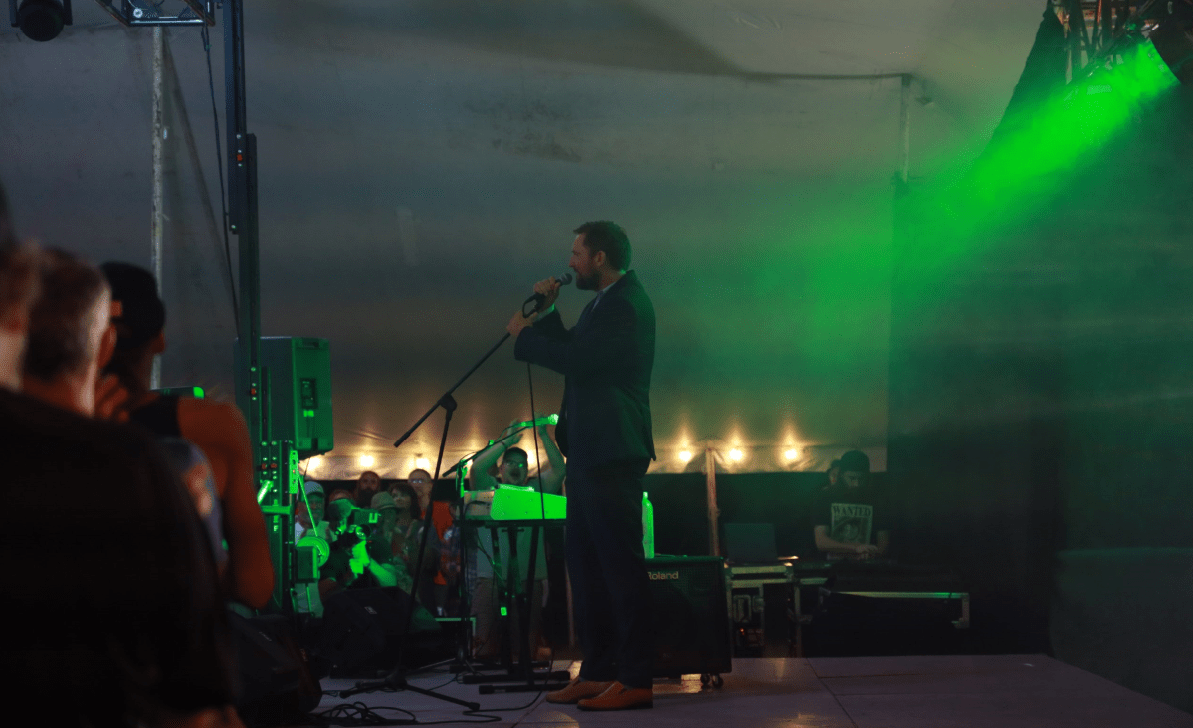
We are thrilled to announce the launch of “Must Be Nice”, the latest comedy special from Owen Benjamin, filmed during the Beartaria Times National Festival and now available for all to enjoy! This event marks a significant accomplishment, not only for Owen but for the entire community that has stood by him.
Owen has faced intense challenges over the years. His refusal to conform to the prevailing entertainment narratives led to numerous cancellations. Online platforms removed him, and live theaters refused to host him simply because of the kind of comedy he performs—honest, raw, and rooted in truth. But instead of shrinking back, Owen doubled down and his audience stood up.

You can’t cancel comedy, as for those that try, they are not just rejecting a comedian from performing, but denying an audience from seeing who they wish.
The cancellation attempts were met by Owen and his audience with the understanding that other peoples platforms and venues are not theirs, which led to the escalation without victim consciousness to build independent platforms and venues.
The community didn’t just offer moral support; they opened up their properties for Owen to perform live, laying the groundwork for something far greater than anyone anticipated. The generosity and unity of his audience led to the funding and development of land specifically for community events and live shows—a place where we can gather, laugh, and celebrate the values we hold dear.
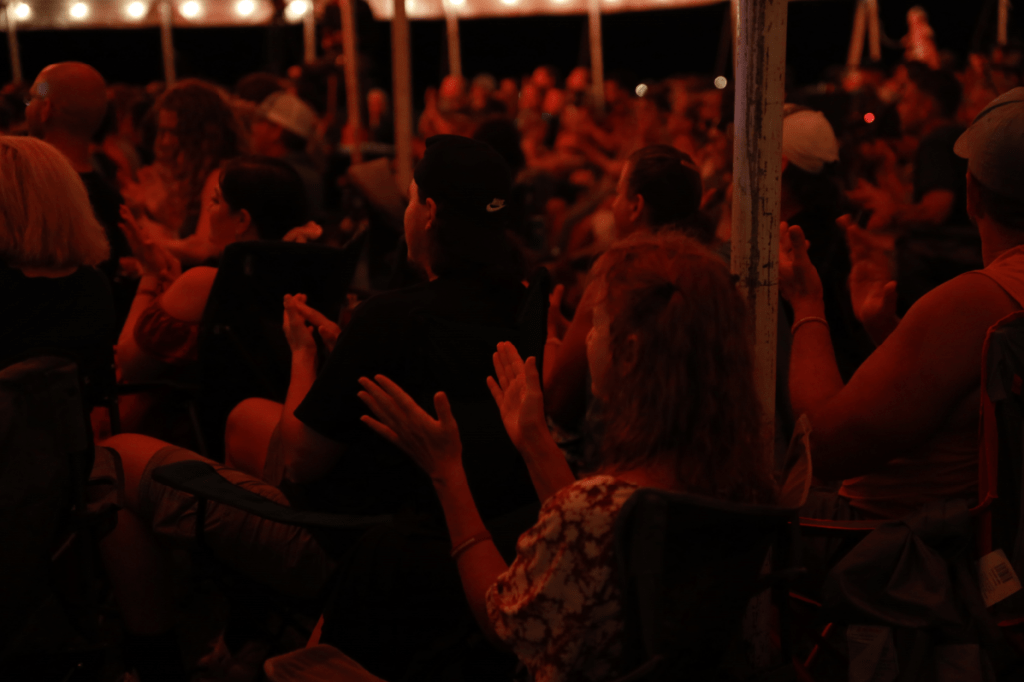
The “Must Be Nice” comedy special represents the culmination of these efforts, demonstrating what can be achieved when a group of like-minded people come together with a vision. The production of this special was taken to a whole new level. With a larger team, high-quality camera rentals, a more advanced sound system, and significant equipment donations—including a massive contribution from Joe Gagan—the special reflects the growth and professionalism of Unbearables Media.
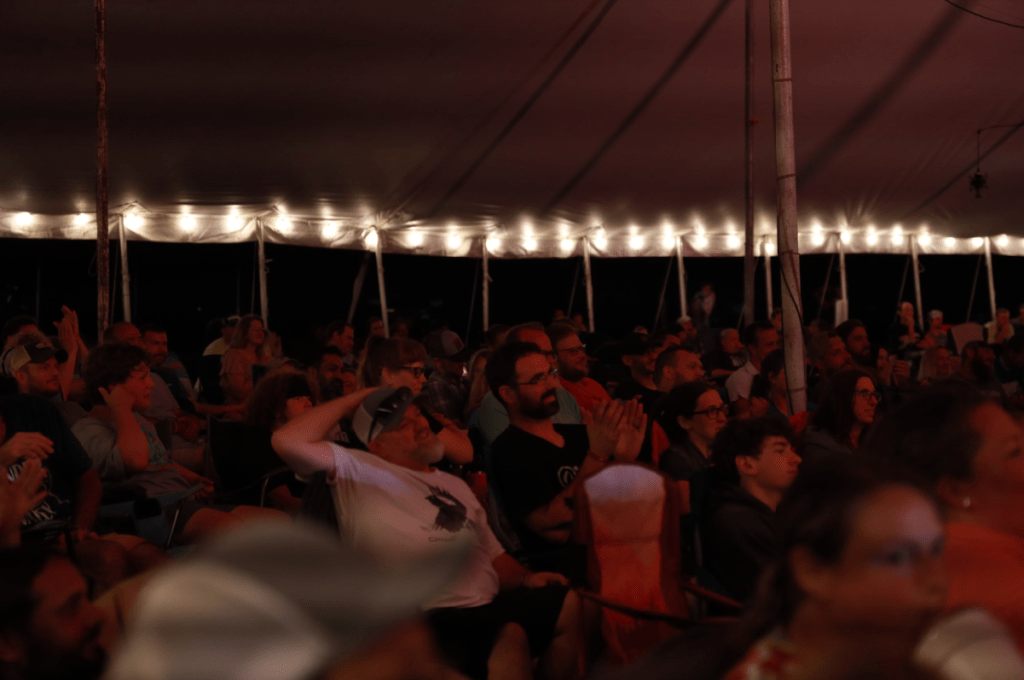
The excitement surrounding “Must Be Nice” is electric. It’s more than just another comedy special—it’s a victory for free expression, for our community, and for the spirit of independence that defines us. The launch on October 11th, marks the beginning of a new era for Owen Benjamin and Unbearables Media, setting a new standard in comedy production and community-driven entertainment.
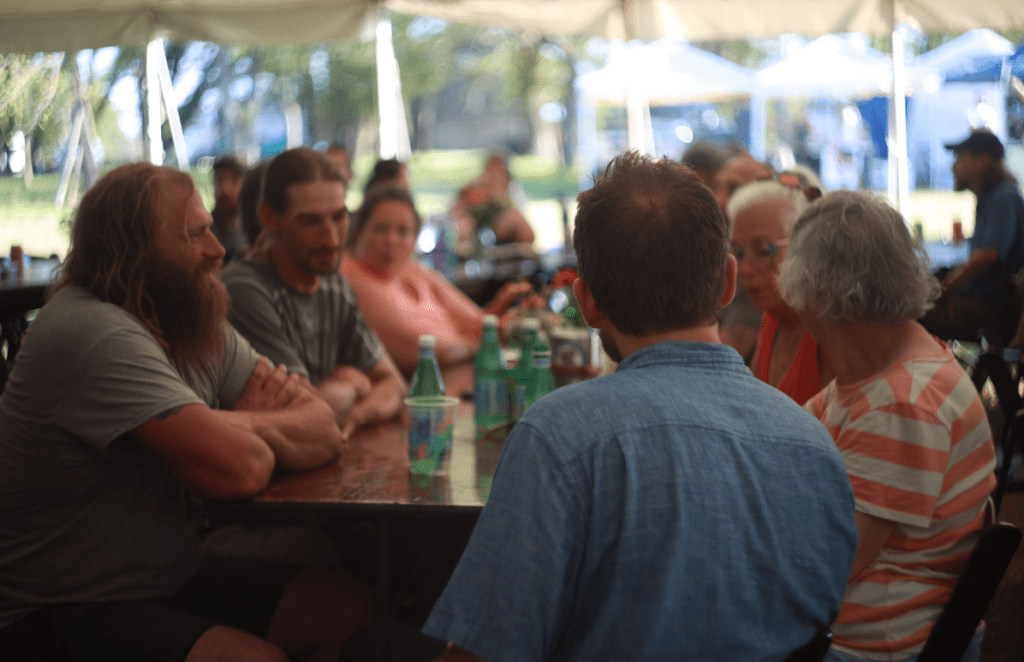
Thank you to everyone who supported this journey, and congratulations to Owen and the entire Unbearables Media team. We can’t wait to see what the future holds as we continue to build and enjoy a world where we can laugh freely and share what matters most.
Get ready to laugh, Beartarians, because Must Be Nice is here!
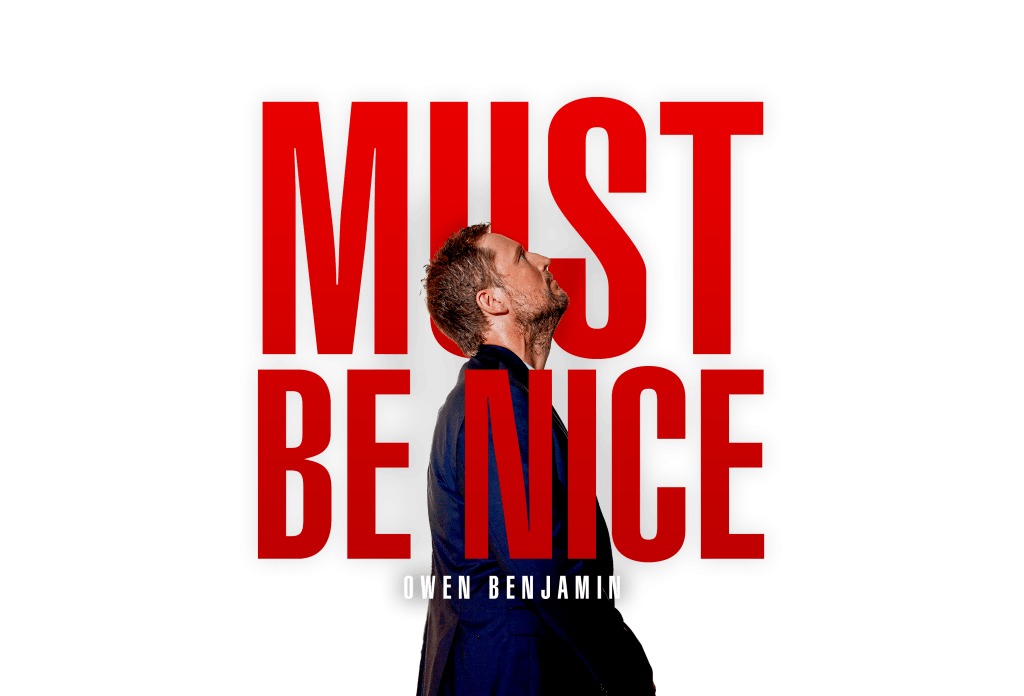
Just Crushing
Legends Spiral Upwards: Embracing Timeless Attributes
We asked our community, “what makes a Legend?”…
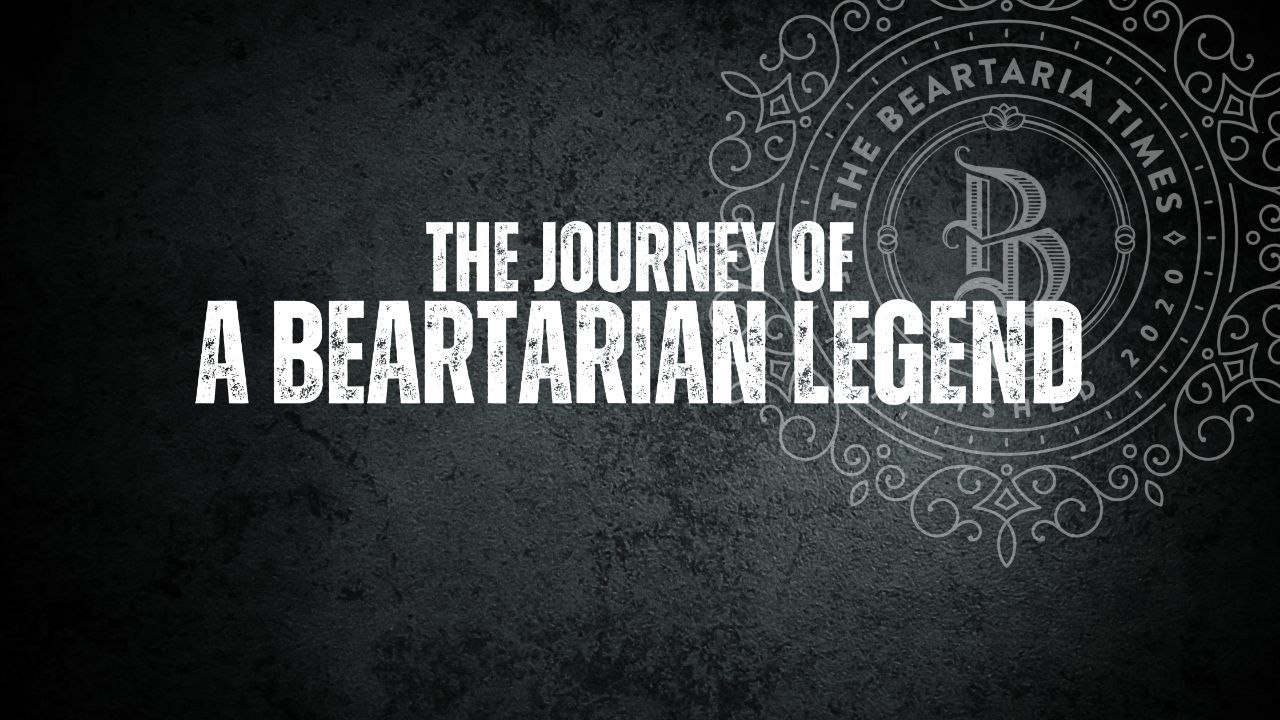
In today’s world, the term “legend” gets tossed around a lot, but in Beartaria, we know that being a true legend goes far beyond fame or popularity. It’s about living in a way others look up to and leaving a lasting impact.
We asked our community, “what makes a Legend?”. The response from our community helped us compile a list of attributes to share so you can embrace the timeless qualities that will set you apart and make you a legend in your own right:
1. Take Ownership, Don’t Blame Others
You’ve got to take full responsibility for your actions. When things go wrong, don’t point fingers—step up and own your mistakes. Doing this builds trust and shows you’re mature enough to handle life’s challenges. Blaming others undermines your influence; taking ownership leads to growth and accurate solutions.
Suggestion: Start by acknowledging your mistakes, no matter how small. When faced with a challenge, ask yourself what you could have done differently. Practice self-reflection regularly through journaling to reinforce this mindset. Share your experiences with others, showing how ownership leads to growth.
2. Emotional Stability, Don’t Get Triggered, Focus on What You Can Control
Life will throw challenges your way, and how you respond to adversity determines the direction in which you’ll find yourself moving when you do. Emotional stability involves keeping your calm and staying focused on what you can control—your thoughts, actions, and feelings.
Don’t get triggered or let emotions control you; stay grounded, knowing you always have power over your responses. If you remain calm while others lose their heads, you’ll not only benefit you will also stand out as a robust and steady presence.
Suggestion: Develop mindfulness practices like prayer and repentance, meditation or deep breathing to manage your emotional responses. Journaling can also help you articulate and process your feelings. Create a list of things you can control and focus on them daily. Whenever you feel overwhelmed, remind yourself of your power over your thoughts and actions.
3. Be Authentic, Remain Truthful in Word and in Deed
Stay true to who you are. Don’t wear a mask or try to be someone you’re not. Authenticity builds stronger relationships and earns respect. Being truthful in your words and actions shows that you have integrity—one of the most essential qualities of a Legend.
Suggestion: Take time to understand your values and beliefs. Practice expressing your thoughts honestly and clearly, even when it’s uncomfortable. Surround yourself with people who appreciate you for who you are. Be mindful of your actions; ensure they align with your words so you are trustworthy. Finding like-minded individuals is an inherent blessing of our community, and connecting is made easier by using tools like the BT App and the BT Map.
4. Be an Example, Work Hard, Compare Less
Focus on setting the right example for others by working hard and staying committed to your path. Don’t waste energy comparing yourself to others. Instead, concentrate on being better than you were yesterday. The only person you should be competing with is yourself.
Suggestion: Set clear personal and professional goals and create a plan to achieve them. Celebrate your progress rather than comparing yourself to others. Engage in daily habits that align with your values, and share your journey with those around you. This not only motivates you but also inspires others to follow suit.
5. Be Ambitious, Don’t Have Despair
Ambition drives you forward, while despair keeps you stuck. Always have a goal in mind, and don’t let setbacks make you lose hope. Even in tough times, maintain your sense of purpose. When you’re ambitious, you’ll see failures as stepping stones rather than dead ends. Your approach to adversity affects how quickly you can use an experience to grow.
Suggestion: Cultivate a growth mindset by viewing challenges as opportunities for learning. Surround yourself with ambitious people who uplift and inspire you. Set short- and long-term goals that excite you, and break them into manageable steps. When faced with setbacks, remind yourself of your vision and why you started.
6. Be Patient, With Yourself and Others
Patience is critical, both with yourself and the people around you. Not everything will happen as fast as you want, and that’s okay. Understand that progress takes time, and so does dealing with others. Be patient with your journey and with those who walk it with you.
Suggestion: Practice patience in everyday situations. When things don’t go as planned, take a moment to breathe and reassess. Remind yourself that progress takes time and everyone is on their own journey. Encourage others by acknowledging their efforts, and don’t rush the process—for yourself and those around you.
7. Produce Goods and Services of Value
Being a legend isn’t just about personal success—it’s about lifting others up. Whether it’s through your work, your contributions, or the way you support your family and friends, what you do should provide value to others. Leave your community, family, and world better than you found them. Being part of creating solutions is intrinsic to Beartarian culture.
Suggestion: Identify the skills and resources you have that can benefit others. Volunteer your time, share your knowledge, or create products that meet community needs. Engage with local organizations to find out where your help is most needed. Regularly ask your friends and family how you can support them, fostering a culture of reciprocity.
8. Show Up In Every Way You Can
Showing up is half the battle, but it’s not just about being physically present. You need to show up mentally and emotionally, too. Be there for the people in your life and for the responsibilities you’ve taken on. Your consistency in effort, presence, and dependability will set you apart.
Suggestion: Make a conscious effort to be present in the moment. Give your full attention in conversations, meetings, or social gatherings. Develop a routine that allows you to prioritize essential commitments and practice being dependable. Create reminders or use a planner to ensure you follow through on your commitments.
9. Be Grateful, Stay Grounded in Gratitude
Gratitude keeps you humble and helps you stay grounded. Legends know that everything they have is a gift and don’t take it for granted. When you appreciate what you’ve been given, you attract even more good into your life and avoid the traps of arrogance and entitlement. You can still enjoy the occasional ‘Muth be nice’ as long as you do it with a genuine appreciation and admiration. Don’t let envy or jealousy rob you of the joy seeing the blessings in life will bring you on your journey.
Suggestion: Start a gratitude journal where you write down three daily things you’re thankful for. Reflect on both big and small blessings in your life. Express your gratitude to others—send thank-you notes, make calls, or simply tell people how much you appreciate them. This practice will keep you grounded and foster positive relationships.
10. Gain Knowledge, Never Stop Learning
A legendary life is built on constant growth. Always learn new things or refine your existing skills. Keep your mind sharp and stay open to new ideas. The more knowledge you gain, the more value you can offer to the world around you.
Suggestion: Dedicate time each week to learning something new. This could be reading books, taking online courses, or attending workshops. Join clubs or groups that focus on your interests, allowing you to exchange knowledge with others. Set learning goals and track your progress to keep yourself motivated. Explore the category groups in the BT App to find inspiration about different skills and topics you can strive to Crush at.
11. Sacrifice Today for a Better Tomorrow for Yourself and Your Posterity
A legendary legacy isn’t just about what you accomplish today—it’s about what you leave behind for the next generation. Legends understand that success requires delayed gratification and the discipline to sacrifice today’s pleasures for tomorrow’s gains. You make sacrifices now to ensure your children and grandchildren a better future. This isn’t just about financial security but the values, work ethic, and example you leave behind. What you do today will echo far into the future, shaping not just your life but the lives of those who come after you.
Suggestion: Evaluate your current priorities and identify areas where you can make sacrifices. Create a plan for your financial goals, such as saving for your children’s education or retirement. Share your vision with your family so they understand the importance of your sacrifices. Model this behavior by making choices that prioritize long-term gains over short-term pleasures. It’s never too early to practice this attribute; don’t let your current season of life dictate how you prepare for the possibilities and potential of the future.
Building Your Legendary Life
Becoming a legend isn’t about being perfect but embodying values others will admire and follow. Take responsibility, stay grounded, be patient, and lift others up. Show up in every way, practice gratitude, and remain true to yourself. Focus on what you can control, delay gratification, and keep learning.
When you live this way, you won’t just create a life worth living—you’ll build a legacy that will stand the test of time.
Join our community app today to meet old friends for the first time and have a community of over 15,000+ people to share your journey with!
Keep striving, keep growing, and never stop building your legendary life!
If you are interested in submitting an article for BeartariaTimes.com as a guest writer please email Editor@BeartariaTimes.com.
Just Crushing
Christopher Gardner Completes First Dome Framing Project in Missouri: Exclusive Interview

Christopher Gardner, known affectionately as Topher, has successfully completed his inaugural dome framing project in Missouri, a significant achievement in his promise to sustainable living and innovative building techniques.
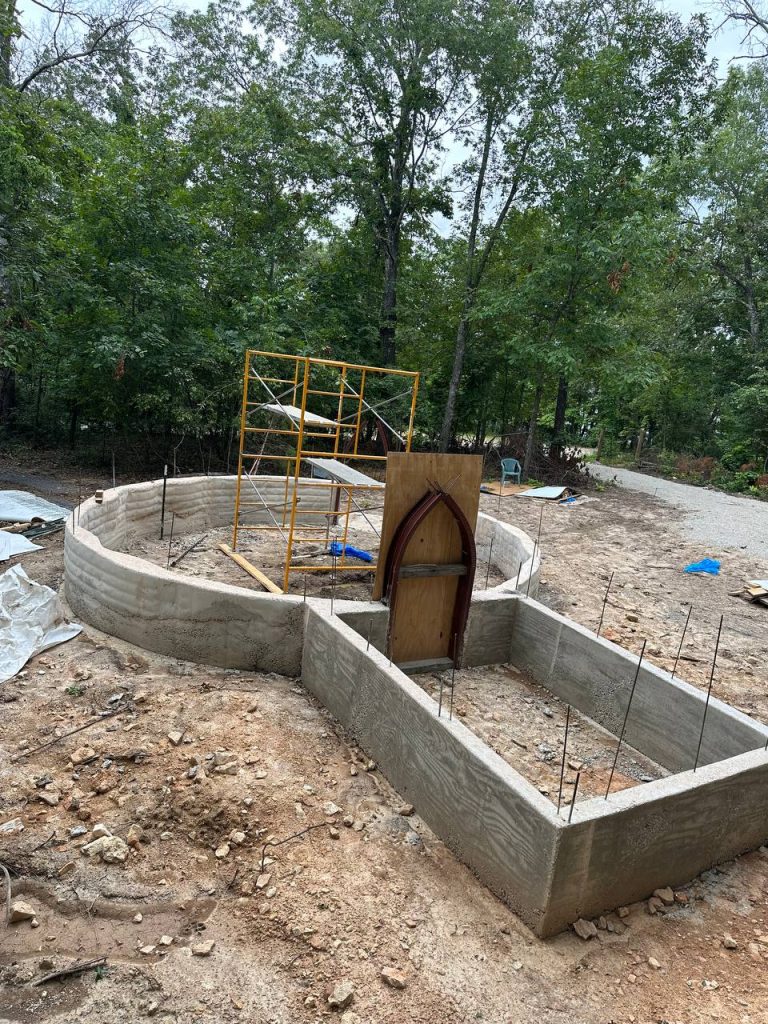
Topher has been hard at work navigating U.S. labor rates and perfecting his techniques. His dedication to sustainability is evident in every aspect of the project, from material selection to construction methods aimed at minimizing environmental impact.
Topher now sets his sights on the Beartaria Ozark Campground, where discussions are underway to host multiple workshops. These workshops aim to educate attendees on his unique building style, recruit laborers for future projects, and create distinctive living spaces for campground guests.
Topher’s successful completion of the dome framing project highlights his expertise and signifies a growing interest in sustainable living and alternative building methods. His initiatives are poised to inspire others to embrace self-reliance and environmentally conscious practices.
As Topher expands his projects and workshops, the community eagerly anticipates the positive impact of his efforts. His commitment to spreading knowledge and fostering community engagement through sustainable building practices sets a precedent for future endeavors in eco-friendly construction and self-sufficient living.
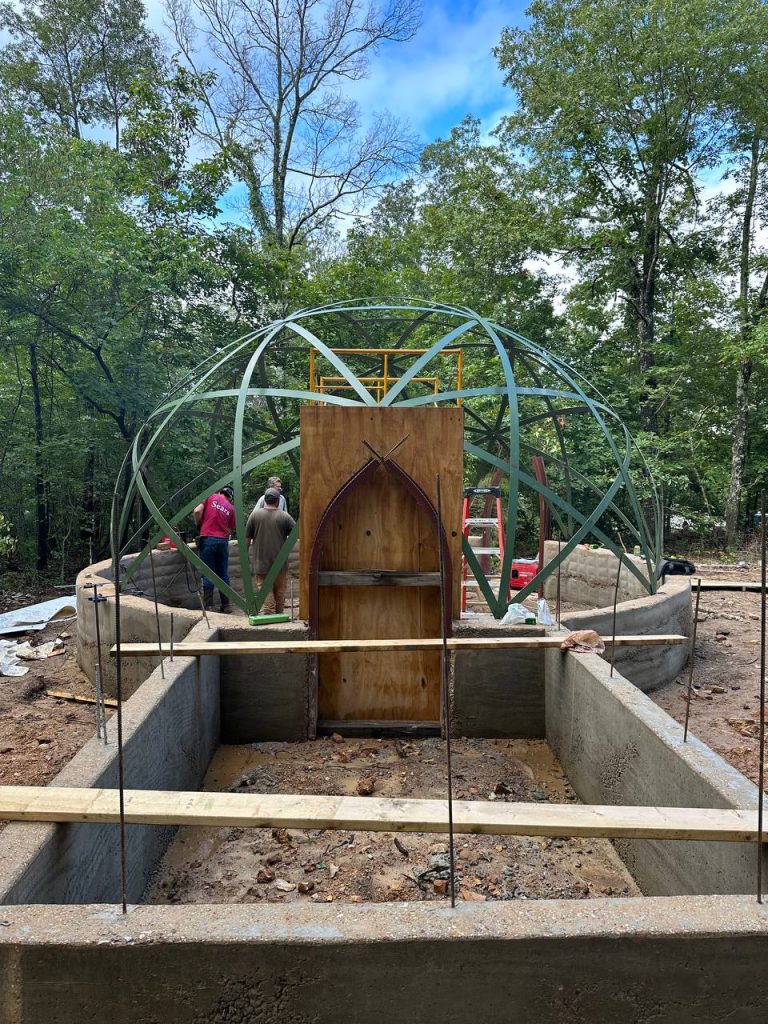
Christopher Gardner’s achievement in completing the first dome framing project in Missouri is a testament to his vision and dedication. His ongoing efforts to educate, recruit, and innovate is sure to leave a lasting legacy in the realm of sustainable living and construction techniques.
We had the opportunity to congratulate Topher and ask a few questions.
Q. What is the most common question about your dome builds?
A. I often get asked how much they cost. The answer varies massively depending on how you finish and furnish your dome.
The foundation and framing is generally half the cost of a conventional building per square foot.
The purpose of the dome, how it is finished and furnished are preferential and could only be quoted on a per-project basis.
While circular or rounded furniture isn’t easy to find, you may want to build your own or have it custom-built.
Q. Is there anything you would like people to know about your Domes?
A. You get a lot fewer bugs, and domes take much less energy to cool and heat, on average 1/10th the energy to heat and cool compared to conventional buildings.
My domes are an Asymmetric Faraday cage.
This is a Japanese star dome design, or Mandala dome, invented by a Japanese mathematician who open sourced his invention.
The type of framing is not my invention, but the methodology and application are proprietary.
My systems and some of the things I’m working on can make these domes highly customizable, not just in style but in practicality. They can be made EMF resistant if you dont mind no internet service and are senstive to EMF. The design can be reinforced to be resilient to windstorms and earthquakes.
Q. What are your dreams & aspirations?
A. My dream and aspiration is for people to learn the virtues of these domes and to adopt them as a practical solution.
People used to have storm shelters below ground, which is a problem with high water tables.
I would like to see all homesteads becoming Domesteads.
I’m working on developing additional methods that make these domes resistant to Wind, earthquake, and fire.
With the correct exposure and the work we are doing here in Missouri, I really see us being able to bring domes to rural areas across America, opening a new market for people looking to add affordable and smart square footage to their properties, increasing value and security.
Q. What are your plans for Beartaria Ozark Campground?
A. Due to recent accomplishments, we have been able to source the needed resources and begin basic training for a dozen guys in this construction style. This has assisted us in working through detailed logistics, figures, and plans for domes on The Beartaria Ozark Campground.
I’m happy to share that, after a year of discussions, The Campground management team and I have established a plan to offer exclusive dome-building workshops and begin construction on the campground.
These workshops will be small groups of twelve people, all hands-on, and they will get to work with me directly throughout the process.
We plan to begin gathering the names and emails of anyone who wishes to participate in these workshops in the coming weeks.
I’m excited to work with Beartaria Ozark Campground and all the legends who are inspired to bring these amazing structures to the U.S.
Q. Is there anything else you would like to share?
A. I would like to thank everyone that has been supporting me, from the followers of my work, my podcast and now all the bears that are getting involved in Missouri to help me get these builds happening!
Thank you, Topher, for all of your work, and we look forward to following you through your mission!
Connect with Christopher Gardner
@Tophur on The Beartaria Times Community App
Christopher Gardner Social Media
.
-

 Lifestyle3 weeks ago
Lifestyle3 weeks agoIndependence Isn’t for Everyone
-

 Farming3 weeks ago
Farming3 weeks agoThe Rise of Small-Scale Farming: Benefits, Challenges, and Tips for Success
-

 Just Crushing2 weeks ago
Just Crushing2 weeks agoLegends Spiral Upwards: Embracing Timeless Attributes
-

 Farming3 weeks ago
Farming3 weeks agoThe Power of Community: How Local Groups Can Strengthen Homesteads
-

 Lifestyle2 weeks ago
Lifestyle2 weeks agoBuilding a Sustainable Off-Grid Home: A Fundamental Guide
-

 Lifestyle2 weeks ago
Lifestyle2 weeks ago10 Essential Skills Every Homesteader Should Master
-

 Just Crushing1 week ago
Just Crushing1 week agoComedian Owen Benjamin Disrupts The Comedy Scene
-

 Farming3 weeks ago
Farming3 weeks agoThe Buzz and Benefits of Beekeeping for Homesteaders



